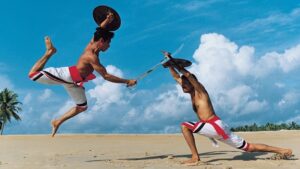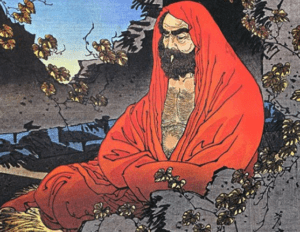First of all, what is Kalaripayattu?

Kalaripayattu is a martial art form that originated in the Indian state of Kerala and is believed to be one of the oldest surviving martial arts in the world. It is a comprehensive system of physical, mental, and spiritual training that includes strikes, kicks, grappling, weapons training, and healing methods.
The word “Kalaripayattu” is derived from two Malayalam words: “kalari,” which means “training hall,” and “payattu,” which means “exercise” or “practice.” The training hall where Kalaripayattu is practiced is called a Kalari. It is considered a sacred space where students learn not just martial arts but also principles of discipline, respect, and self-control.
Kalaripayattu is known for its fluid, circular movements, which are designed to make the practitioner agile, flexible, and powerful. It is also known for its use of swords, spears, daggers, and flexible weapons like the urumi, a sword with a flexible whip-like blade. In addition to physical training, Kalaripayattu also includes meditation, breathing exercises, and healing techniques such as marma chikitsa, which involves the manipulation of energy points in the body.
The history of Kalaripayattu

The history of Kalaripayattu is believed to date back to the 3rd century BCE in the Indian state of Kerala. It is believed to have originated as a form of combat training for warriors, with a focus on physical fitness, weapon training, and hand-to-hand combat techniques.
Over time, Kalaripayattu evolved into a comprehensive system of physical, mental, and spiritual training, with an emphasis on self-discipline, respect for others, and control over one’s own body and mind. It became an important part of Kerala’s culture and was practiced by both men and women.
One of the earliest references to Kalaripayattu can be found in the Tamil classic “Silappatikaram”, which was written in the 2nd century CE. The book describes a fight between two warriors trained in Kalaripayattu.
Kalaripayattu also played a significant role in the history of Kerala. During the 16th and 17th centuries, Kerala was ruled by various foreign powers, including the Portuguese, the Dutch, and the British. Kalaripayattu practitioners were known to have played an important role in resisting these foreign invasions and defending their homeland.
Who invented Kalaripayattu?
The origins of Kalaripayattu are shrouded in myth and legend, and there is no known individual who can be credited with inventing the martial art form. Instead, Kalaripayattu is believed to have evolved over thousands of years through the collective efforts of generations of practitioners.
According to legend, the god Vishnu (god of Preservation) is said to have taught Kalaripayattu to the sage Parasurama, who in turn passed it down to his disciples. Another legend attributes the development of Kalaripayattu to the Hindu sage Agastya, who is said to have developed the martial art form as a way to defend himself against demons (I just love these legends).
Historically, Kalaripayattu was developed and refined by various communities in the Indian state of Kerala, including the Nairs, the Ezhavas, and the Cholas. These communities developed their own styles and techniques, and over time, Kalaripayattu evolved into a comprehensive system of physical, mental, and spiritual training that is still practiced today.
It is important to note that while Kalaripayattu has a rich history and tradition, it is also a living and evolving art form that continues to adapt to the needs of modern times.
Bodhidharma and Kalaripayattu.

Bodhidharma, the legendary figure in Chinese Zen Buddhism, is said to have traveled from India to China in the 5th or 6th century CE. According to some legends, he may have known about Kalaripayattu before his journey to China. However, it’s important to note that there is no historical evidence to confirm that Bodhidharma was a master of Kalaripayattu or had any significant knowledge of martial arts.
While the idea of Bodhidharma being a martial arts expert lacks historical backing, there are certain similarities between Kalaripayattu and some martial art forms. Both Kalaripayattu and Shaolin Kung Fu emphasize the use of circular movements and aim to develop physical strength, agility, and mental discipline, but again, that description fits many styles.
In summary, while Bodhidharma’s connection to martial arts, particularly Kalaripayattu, is mostly rooted in legend rather than historical fact, it’s an intriguing aspect of his story that continues to be a subject of interest and speculation.
Furthermore, Kalaripayattu is believed to have had an influence on other martial arts styles that developed in Southeast Asia, such as Muay Thai and Silat. This suggests that Kalaripayattu may have played a role in the development of martial arts in other parts of Asia, including China, but again, there is no historical evidence to support it.
Last comment.
Today, Kalaripayattu is practiced not just in Kerala but also in other parts of India and around the world. It is recognized as a valuable cultural and martial arts practice that continues to evolve and adapt to modern times.
Thanks for reading.
Gert
